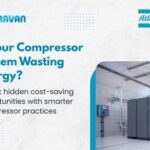Energy Recovery in Compressor Systems

Many installations that produce compressed air offer significant and frequently unutilised energy saving possibilities in the form of waste energy recovery. In large industries, energy costs can amount to 80% of the total cost of compressed air production. However, a lot of this energy can be recovered, which in turn will save you a lot of money.
What is waste energy recovery in compressor installations?
When air is compressed, heat is formed. Before the compressed air is distributed into the pipe system the heat energy is extracted, and becomes waste heat. For each compressed air installation, the issue of sufficient and reliable cooling capacity for the installation must be addressed. Cooling can take place either by means of the outdoor air or a cooling water system that uses municipal water, stream water or process water in an open or closed system.
A compressor central plant in a large industry that consumes 500 kW over 8,000 operating hours per year represents a yearly energy consumption of 40 lakh kWh which at approximately 8 Rs/kWh translates to 3.2 Crores. The possibilities for recovering substantial amounts of waste heat via hot air or hot water are real. As much as 94% of the energy supplied to the compressor can be recovered, for example, as 90°C hot water from oil-free screw compressors. This equals to roughly 2.95 Crores recovered in energy costs.
This fact illustrates that saving measures quickly provide substantial return. The return on investment for energy recovery is usually as short as 1–3 years. In addition, energy recovered by means of a closed cooling system enhances compressor operating conditions, reliability and service life due to an equalised temperature level and high cooling water quality, to name but a few advantages.
Nordic countries are somewhat of a forerunner in this arena and energy recovery has been standard practice for quite some time now for compressor installations. Most medium to large compressors from the major suppliers over there are now adapted for fitting with standard equipment for waste heat recovery. This is being adopted in India now by companies such as TVS Motors, Tenneco and Gabriel India
How do we calculate the recovery potential?
The laws of physics dictate that nearly all energy supplied to a compressor installation is converted into heat. The more energy that can be recovered and utilised in other processes, the higher the system’s overall efficiency.
To calculate the amount of recovered energy, we will use the following formulae.
1. Recovered energy formula:
W = Recovered energy (in kWh/year)
K1 = Portion of time with loaded compressor (hrs/year)
Q1 = Available coolant power with loaded compressor (kW)
K2 = Portion of time with off-loaded compressor (hrs/year)
Q2 = Available coolant power with off-loaded compressor (kW)
TR = Total time of recovered energy demand (hrs/year)
Once we calculate the amount of recovered energy (W), we can use the Savings formula.
2. Savings Formula:
Where:
• W = recovered energy (from the main formula)
• ep = energy price (Rs/kWh)
• η = efficiency of the heat source (e.g., 90% = 0.9)
Example:
Say:
• W = 1,00,000 kWh/year (recovered)
• Ep = 8 Rs/kWh
• η = 0.85 (i.e., 85% efficiency)
In many cases the degree of heat recovery can exceed 90% if the energy gained by cooling the compressor installation can be utilised efficiently. The function of the cooling system, the distance to the point of consumption, and the degree and continuity of the heat requirement are all decisive factors. With large thermal flows, selling the recovered heat energy is a possibility that should not be ignored. The electrical energy supplier could be a potential customer, and investment, sub-order and delivery could readily be negotiated. An opportunity for savings also exists by coordinating energy recovery from several processes.
Get in contact with us to see how we can help you save energy today!
This article was sourced from the Atlas Copco website with several key changes. The original article can be found at: https://www.atlascopco.com/en-us/compressors/wiki/compressed-air-articles/energy-recovery


